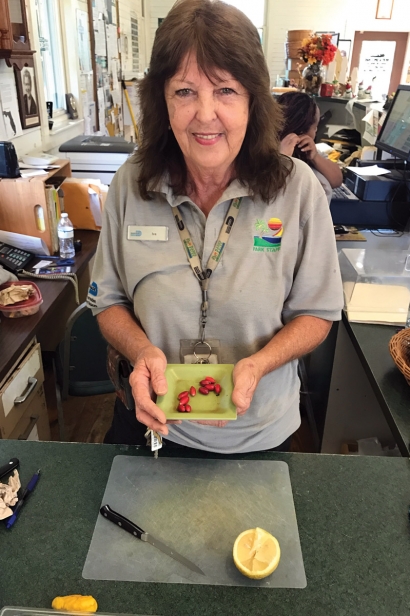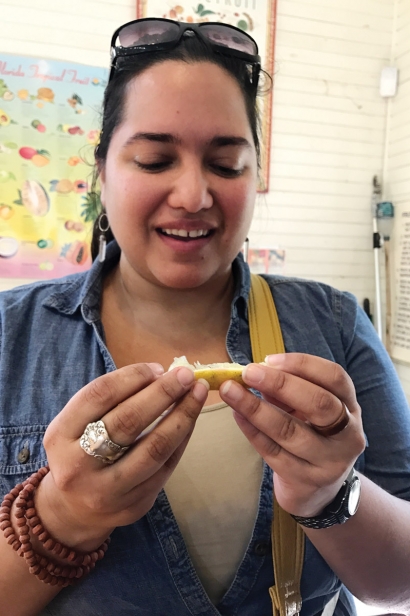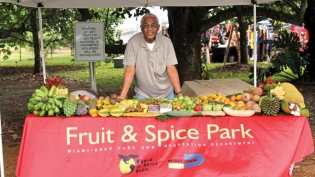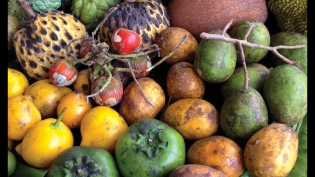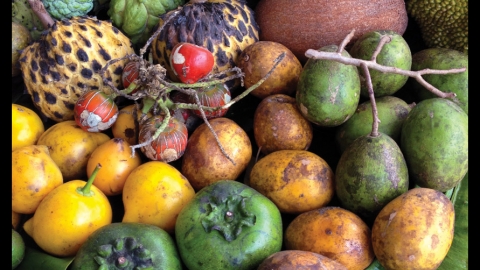Tasting Again … Thanks to the Miracle Fruit
Miracle fruit (Synsepalum dulcificum), a Ghana native that grow easily in South Florida, has been in the news lately for its ability to mask unpleasant tastes and make sour seem sweet. The science behind this, experts say, is a glycoprotein in the fruit called miraculin that binds to taste receptors. For those who eat the fruit, flavors are temporarily altered, including undesirable tastes, like the metallic taste food gets after chemotherapy.
One of the fruit’s biggest advocates is Iva Hegg, guest services representative at Fruit and Spice Park in the Redland. On any day, she and her colleagues give tours and offer guests samples of tropical fruits gathered from the park – carambola, rollinia, ambarella, calamondin, black sapote, to name just a few. But it is Hegg who’s made it her mission to spread the word about the miracle fruit’s taste-altering qualities in an effort to reach someone – anyone – who might be helped, whether they’re undergoing chemo or taking medications that affect their sense of taste, or have lost their taste and smell after surgery.
She counts at least eight people who have been helped by the fruit on her watch. “One of our neighbors came in. He hadn’t been able to taste food since being intubated years before – he said everything tasted like cardboard,” she says. She gave him the fruit and asked if he liked mango. “Of course I do, I’m Cuban!” he told her. When he tasted it, he started sobbing like a baby. “I feel like a child tasting fruit for the first time!”
The effects of miracle fruit last about an hour, but that’s enough for someone to eat and taste a meal. “We gave a fruit to a man so he could enjoy Thanksgiving dinner,” she says.
Good for Diabetics
Miracle fruit can also help diabetics and dieters naturally reduce their sugar intake without giving up their favorite foods, drinks or desserts. According to Miracle Fruit Farm, a Redland grower dedicated to growing miracle fruit berries, the fruit is useful for diabetic patients with insulin resistance, “It is not an artificial sweetener. It is an all-natural way to enjoy sweet flavors and keep blood glucose levels in the target range without the risk of overloading with unwanted carbohydrates.”
When regular park visitors sample the fruit and experience its effects, Hegg knows they can become potential advocates for medical uses. Recent visitors Melanie Riley and Chris Rugowski, visiting from Green Bay, Wisconsin, agreed to taste the fruit. First, Hegg makes them try a tart lemon, a calamondin and a starfruit. Next, she gives the visitors a miracle fruit to eat and instructs them to make sure to chew it and cover their tongue with the pulp. Then she asks them to taste the fruits again. “Wow!” says Riley, sucking on the pucker-inducing lemon again. “The lemon tastes like lemonade – no, like a Starburst!”
Miracle fruit’s dramatic effects work best with sub-acid fruits like grapefruit, strawberries and lychees; sour foods like pickles, vinegar and cheeses. Beer, dark chocolate, tonic water and BBQ sauce are also favorites. Bland foods like milk, fries and American cheese show little effect with the fruit. One of its recreational uses is flavor-tripping parties where guests can taste the changes for themselves. And if those flavor-trippers have the opportunity to share their experience to someone who’s lost the ability to taste again, even better. For the sick, “eating is half the battle,” says Hegg. If the miracle fruit can boost their appetite and their spirits, even briefly, it can live up to its name.
Miracle Fruit Connections
Visitors can sample miracle fruit at Fruit and Spice Park when they’re available, see the plants and hear about their applications from park guides. Robert Is Here in Florida City sells fruits year-round.
Want to grow your own? Save your seeds after eating the berry to plant. Sow them in a container with potting soil, ideally peat-based. Keep soil moist. Seeds need two to three weeks to germinate. Miracle fruit shrubs, about 6 to 15 feet, can be grown in your back yard. They do best in partial shade and soil with low pH. You can buy plants from the Rare Fruit and Vegetable Council of Broward at its twice-yearly sales, at Grimal Grove on Big Pine Key and year-round at Miracle Fruit Farm, which also sells fruits, melting tablets and powder.



